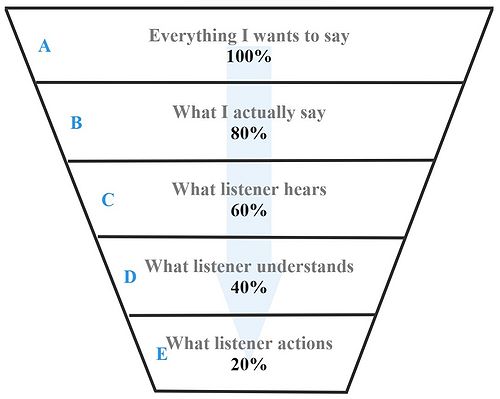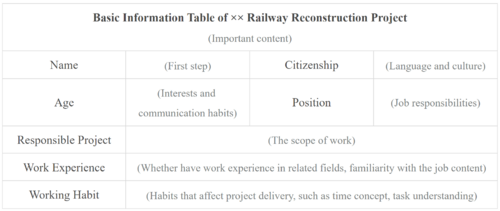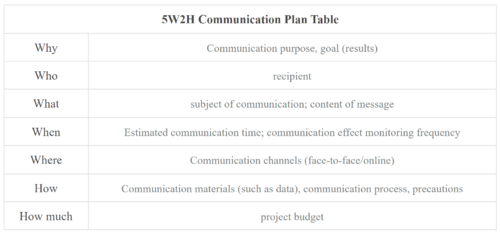Communication Funnel Problems in Project Management
Written by Jianan Yang (s230033)
Contents |
Abstract
Projects are made by people, and the project management process is inseparable from communication between people. Everyone has their own identity, professional knowledge, interests, and personality. This makes communication management an important topic in project management. One of the common phenomena is the "communication funnel problems", which vividly illustrate the loss of information in the process of transmission. This article introduces the definition and impact of the communication funnel, analyzes its causes, and proposes solutions for project managers who encounter this problem. The purpose of this article is to improve the efficiency of information transmission in project management.
Big Idea
What are Communication Funnel Problems
The term "communication funnel" originated in the sales industry. In 1898, the American advertising advocate Elias St. Elmo Lewis formulated the slogan "Attract attention, maintain interest, create desire", and later added the fourth term "get action" [1], forming the AIDA hierarchical model. Marketers use AIDA to narrow down targets and identify potential customers step by step. This phenomenon is described as "Purchase Funnel" [2], as shown in Figure 1. With the continuous development of marketing and information dissemination, the concept of "communication funnel" has been widely used in information dissemination activities in different fields and has become a general concept.
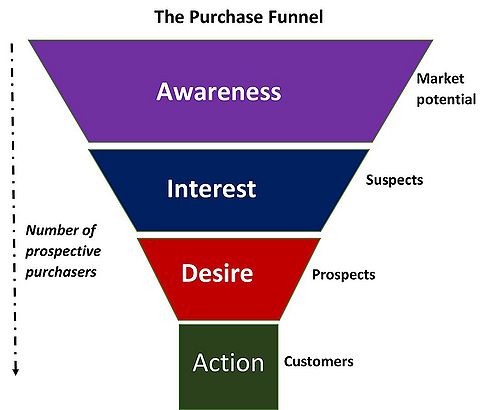
Communication funnel problems refer to the phenomena in which information is lost, misunderstood or distorted layer by layer during the transmission process. If what one person wants to say is 100%, then what he actually says is 80% because of expressive skills and other reasons. Due to the perceptual filters, listeners may only hear 60%, understand 40%, and final action 20% [4]. This process looks like a funnel, as shown in Figure 2.
Impacts of Communication Funnel Problems
Projects are made by people, so communication runs through the entire project management process. The communication funnel often leads to inaccurate or incomplete information in project management, which adversely affects the project, such as delaying progress, reducing quality, increasing costs, and ultimately leading to failure to achieve project goals. There are many cases in project management, below is a common example.
A railway reconstruction project needs to replace dilapidated track components within one month to ensure track safety, and the tracks that do not affect traffic can be kept. At the project kick-off meeting, the project manager said to the person in charge of track technology who participated in the project for the first time: "Please try to complete the replacement of old track components within one month." The track technical leader heard the keywords "replace" and "try to within one month". He thought his task is to complete the removal of all old tracks and the installation of new tracks. And the plan is just an approximate time, it doesn't matter if delay of one week. As a result, only 80% of the dilapidated tracks were demolished in one month due to continuous rainy days. The later tasks were delayed because the laying of the new track was not completed, and the unplanned demolition of the old track increased the project cost.
Causes of Communication Funnel Problems
The above case is a typical communication funnel problem. The project manager only described 80% of the task requirements, and the track technical leader only heard 60%, understood 40%, and finally implemented only 20% of the original task. In this information transfer process, due to the lack of a communication plan, the simplification of information, and the difference in the work experience, some information is lost and the communication effect is reduced. This is part of the reason for the communication funnel. The following discusses the four main components of the communication process to analyze the reasons for communication funnel problems.
The process of communication involves four major parts: the communicator, the message, the medium, and the recipient[5], as shown in Figure 3. First, the communicator is the originator of the message. In project management, a project manager typically takes on this role. It is an important role, as the project manager selects the message to be sent among various information channels and content, identifies the appropriate recipient, and translates the message into a language that the recipient can understand. At the same time, the effectiveness and importance of information are also affected by the project manager's actual wording and (in face-to-face communication) body language. Second, the general message includes tasks, thoughts, and feelings. In project management, the main message is the task. The accuracy of task descriptions determines the effectiveness of communication. Then, different mediums are used to transmit information, such as phone calls, text messages, and emails. The kind of medium will affect the emotion and richness of the information. For example, emails are more formal than phone calls. Last, the recipient decides the outcome of the communication, and his or her cultural background, work experience, and ability to interpret information determine the effectiveness of the communication.

Based on the analysis of the above four main parts, it can be concluded that the causes of the communication funnel problem mainly include:
- The communicator does not fully know the recipient.
- The communicator has no plan for communication, which affects the ability to express.
- The communication channel is single, and the advantages of different channels are not fully utilized.
- The recipient is passive in communication.
Solutions to Communication Funnel Problems
"The purpose of communication management is to enable stakeholder interactions that are effective and likely to contribute to the successful delivery of the project’s outcomes and the successful realization of benefits"[6]. Combining the above case analysis and the latest version (DS/ISO 21502:2020) of Project, program and portfolio management-Guidance on project management, there are four methods to solve the problem of the communication funnel. Methods 1-3 are suitable for communicators and method 4 applies to the recipient.
- Understand the basic information of the recipient, to enhance mutual understanding and cooperation. Such as cultural background (when communicating across different cultures), work habits (such as the understanding of delivery time by the track technical leader in the previous case), and information needs.
- Develop a communications plan that provides timely, accurate, and comprehensive information. Including communication time, frequency, and task-specific content (the 5W1H method can be used).
- Define communication channels to minimize communication risks. Choose different channels (such as mail, telephone, face-to-face meetings, and online project management tools) based on the urgency and importance of information, and multiple channels can be combined. As in the previous case, the project manager can form a written document and send it by email after the project kick-off meeting to reduce information loss. At the same time, use Microsoft Project Planner, to monitor and evaluate the effect of communication by regular follow-up on the completion of tasks.
- Active listening to remove barriers in the delivery of information. The recipient clarifies and confirms what has been heard and understood by proactively asking questions and restating the information delivered by the communicator [7]. For example, in the previous case, the track technical leader can clarify the communication content more clearly by asking questions. Such as "Do all the old tracks need to be replaced? Or just the tracks that do not meet safety standards need to be replaced?" and "Is the project completion deadline one month? Is the task allowed to be postponed due to special reasons? How long can the task time be extended at most?"
Application
By using tools, the occurrence of communication funnel problems in project management can be effectively reduced or even avoided. Below are guidelines for using the four tools, along with recommendations for when to apply them.
1. Basic Information Table
It is argued that one can only listen and understand your message if they have the minimum common ground, language, etc[8]. As shown in Table 1, knowing the basic information, the communicator can roughly find out the common experience, common language, and common interest with the recipient when it is necessary to cooperate with a new colleague. If both are familiar with railway construction projects, they can use proper nouns to communicate. At the same time, if they have different cultural backgrounds or work backgrounds, special situations need to be dealt with. For example, when communicating in a non-native language, it is necessary to speak slowly and clearly. The collection of this basic information will help project managers formulate communication plans and reduce the 20% loss from idea to expression.
2. 5W2H Communication Plan Table
In the communication funnel, the communicator will be unable to 100% express what is in his mind due to the influence of factors such as expression skills. In response to this problem, the 5W2H communication plan table, Table 2, can help project managers formulate a communication plan before communication, describe specific task requirements, and make communication more efficient.
3. Different Communication Channels
In project management, common communication channels include oral (such as on-site face-to-face, telephone, and video conference) and written (such as email). Among them, the oral channel is a real-time conversation, which is suitable for complex, ambiguous, and emotional situations, such as projects that require the co-creation of value or negotiation. The written channel is a non-real-time and one-way communication at every time. It is suitable for conveying simple information, specific tasks, or "sealing mutual agreements"[8].
The meeting is a general oral communication scene, whether face-to-face or online video, and is an important activity in project management. Efficient meetings will undoubtedly reduce the occurrence of communication funnels. Clarifying the type of meeting and planning the meeting process are the prerequisites for efficient meetings. As shown in Table 3, common types of meetings include decision-making meetings, progress management meetings, idea-mining meetings, and information communication meetings[10]. After clarifying the type and purpose of the meeting, planning the meeting process will help ensure the quality of communication. Refer to Table 4 for steps before, during, and after the meeting.
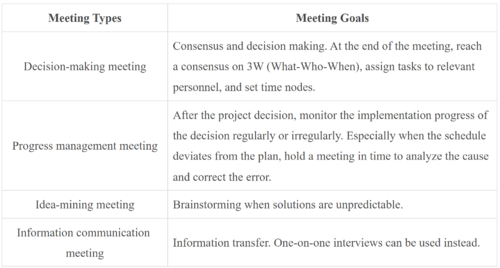
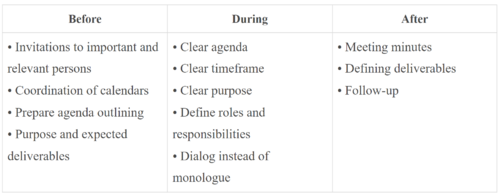
Formal emails are not always popular compared to informative and emotional spoken language. So, "When possible, talk instead of type" [8]. However, in project management, the use of email cannot be avoided. Maybe you are a project manager, who often needs to send information by email, but the communication effect is minimal. Or you are a project staff, need to check your mailbox frequently to prevent missing information, which is very annoying. Here are golden email rules that can help you solve your problem. It not only improves the efficiency of information transmission but also efficiently handles numerous email tasks, as shown in Table 5.
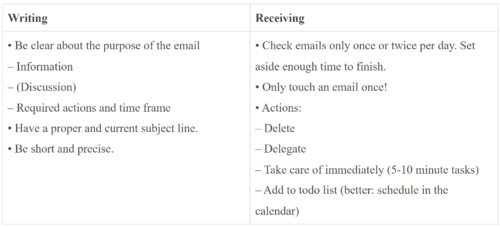
4. Active Listening
In the communication funnel problem, the recipient's acceptance and understanding of the information have a great influence on the effectiveness of the communication. Though the recipient is in the downstream of information transmission, if he or she can participate in the communication with a proactive attitude, it will not only reduce the loss of information but even improve the integrity of the information. Among them, the recipient's active listening plays an important role.
Active listening is a person's willingness and ability to hear and understand[11]. This means that it is not just an attitude, but the skill of listening can be improved through training. Active listening involves six skills: paying attention, holding judgment, reflecting, clarifying, summarizing, and sharing [11]. It turns out that paying attention and providing feedback can effectively avoid communication funnel problems.
(1) Pay attention[8]
-When communicating, mute mobile phone messages and choose a quiet and secluded meeting room to avoid environmental distractions.
-Put aside distracting thoughts and focus on the content of the communication at the moment.
-Not mentally prepared to contradict the communicator's expressions and body language.
-If you find it difficult to focus, try mentally repeating what the communicator said to reinforce the message and maintain focus.
(2) Provide feedback information[8]
Values, beliefs, biases, experiences, information content, and the medium used to deliver the message[12] will affect how the receiver processes the received information, so the feedback of the recipient is very important in the communication process.
-Use body language to show that you are participating in the communication process. Such as the occasional nod, smile, or other facial expression, and make sure the gesture is open and engaging.
-Clarify the key points of communication by asking questions, paraphrasing, or summarizing. Use expressions like "Is this what you want to express?" "That's what I heard".
Limitations
1. Basic Information Table
This tool is suitable for communicators at the initial stage of establishing a working relationship. It has certain requirements for the observation and induction skills of communicators. In solving the communication funnel problem, a completed information table means adequate preparation, which can help communicators build confidence. At the same time, the collation process helps the communicator understand the recipient, and can adjust the expression method and information focus in advance. This helps to reduce the information loss in the first stage of the communication funnel (part A in Figure 2).
"Responsibility, respect, fairness, and honesty" are considered to be the most important values in the project management community. The PMI Code Ethics and Professional Conduct is based on these identified 12 principles of project management, encouraging "being a diligent, respectful, and caring steward"[13]. This tool shows the communicator attaches importance to the communication process and respect for the partner.
2.5W2H Communication Plan Table
This tool works on stages 1 and 2 of the communication funnel (see A&B in Figure 2). Compared with tool 1, the communication plan table is more practical for the implementation process of communication, and meets the project management standard: "The communications approaches and methods chosen should be planned and documented"[6]. This helps communicators clarify expectations and anticipate possible contingencies in advance. In addition, 7.16.3 of DS/ISO 21502: 2020 points out that "a system should be defined and established for receiving, identifying, securely storing and maintaining information and documentation, such that the information and documentation can be distributed and is retrievable only by those individuals who are authorized to access it" [6]. Compared with making frequent communication plans, a more efficient way is to establish standard work documents based on similar project experiences, such as including project stages, work requirements, common emergencies, and solutions.
3. Different Communication Channels
By analyzing and comparing commonly used communication channels, communicators can choose the appropriate medium independently. They can learn how to use different mediums correctly and avoid information loss due to inappropriate mediums. It addresses the third stage in the communication funnel problems (see C in Figure 2). In addition to these common communication channels, online project management tools (such as Microsoft Project Planner) also increase options for communication channels, which need to be further explored.
4. Active Listening
The discussion of active listening skills aims to address the third and fourth stages of the communication funnel problems (see C&D in Figure 2). Through the recipient's active participation in the communication process, the loss of information is reduced. Although this article focuses on encouraging active listening by the recipient, the real communication process is never one-way. The communicator also needs to actively listen to the receiver's expression to achieve mutual respect in the project management process [13].
The fifth stage of the communication funnel problem (see E in Figure 2) is not only related to the efficiency of information transmission, but also affected by many other factors such as climate, environment, and resource allocation. From a communication point of view, it may be one solution that the communicator can increase follow-up and supervision efforts, and the recipient often gives feedback on task progress.
Annotated Bibliography
[2] The association of the funnel model with the AIDA concept was first proposed in Bond Salesmanship by William W. Townsend in 1924. The original text is "The salesman should visualize his whole problem of developing the sales steps as the forcing by compression of a broad and general concept of facts through a funnel which produces the specific and favorable consideration of one fact. The process is continually from the general to the specific, and visualizing the funnel has helped many salesmen lead a customer from Attention to Interest, and beyond" (p. 109).
[6] Section 7.13 of DS/ISO 21502: 2020 guides communication management in project management, including planning communication (7.13.2), distributing information (7.13.3), and monitoring the impact of communication (7.13.4), which respectively involve communication in three stages: before, during, and after. Section 7.16 describes the management of information and documents, including the identification, storage, and retrieval of information that should be managed.
[10] This book systematically introduces Bezos' unique meeting method at Amazon, and explains it in combination with representative cases of daily work. Effectively solve the communication funnel problem in project management through efficient decision-making, communication, and execution process.
References
- ↑ Edward. K. S. Jr., 1925. The Psychology of Selling and Advertising. New York: Mcgraw-Hill Book Company. 349. https://babel.hathitrust.org/cgi/pt?id=uc1.$b38792&view=1up&seq=25
- ↑ 2.0 2.1 William W. T., 1924. Bond Salesmanship, 1st ed. New York: Henry Hold and Company. 109. https://babel.hathitrust.org/cgi/pt?id=uc1.$b37470&view=1up&seq=131
- ↑ https://commons.wikimedia.org/wiki/File:The_Purchase_Funnel.jpg
- ↑ Qifeng, 2019. McKinsey Business Communication and Text Writing. China: Tianjin Science Technology Publishing House.
- ↑ 5.0 5.1 Hollingsworth, S., 1987. Communications management. PM Network, 1(3), 45–48. https://www.pmi.org/learning/library/communications-management-9110
- ↑ 6.0 6.1 6.2 6.3 DS/ISO 21502: 2020, Project, programme and portfolio management-Guidance on project management[S]. Copenhagen: Dansk Standard, 2020.
- ↑ 2020. Elements of Active Listening. The Volunteer Management Report, 25: 8-8. https://doi-org.proxy.findit.cvt.dk/10.1002/vmr.31357
- ↑ 8.0 8.1 8.2 8.3 8.4 8.5 8.6 8.7 Christian T., 2023. Project Management: People[PowerPoint slides]. DTU Project Lab. https://learn.inside.dtu.dk
- ↑ Kotaro Watanabe, 2019. 5W1H Super Thinking Technique. Taiwan: Yeren Publishing House.69.
- ↑ 10.0 10.1 10.2 Satō, M., 2021. How Bezos Holds Meetings. China: Wanjuan Publication Company.https://a.co/d/2nxGx0S
- ↑ 11.0 11.1 Hoppe, M. H., 2018. Active Listening: Improve Your Ability to Listen and Lead, 1st ed. United States: Center for Creative Leadership.12.
- ↑ Rajkumar, S., 2010. Art of communication in project management. Paper presented at PMI® Research Conference: Defining the Future of Project Management, Washington, DC. Newtown Square, PA: Project Management Institute.
- ↑ 13.0 13.1 Project Management Institute, Inc. (PMI). (2021). A Guide to the Project Management Body of Knowledge (PMBOK ® Guide) – 7th Edition and The Standard for Project Management - 3. Project Management Principles. Project Management Institute, Inc. (PMI). Retrieved from https://app.knovel.com/hotlink/pdf/id:kt012LZF11/guide-project-management/project-management-principles
